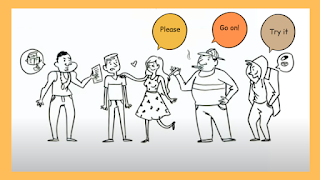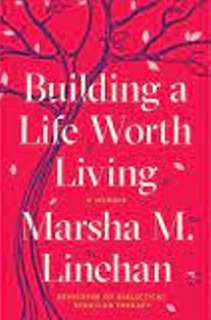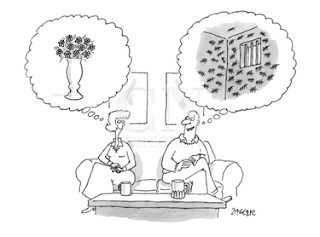The predominant and most widely-used
school of thought in use for the psychotherapy of borderline personality
disorder (BPD) is called dialectical behavior therapy (DBT). Marsha Linehan, a
psychologist at the University of Washington, was the person who came up with
the theory and treatment ideas. The treatment paradigm has been shown in studies to be somewhat
effective in reducing some symptoms of the disorder, but mostly ineffective
in helping patients solve their problems with love and work.
She believes that a combination
of a genetic propensity to be over-reactive combines with a so-called “invalidating
environment” to produce the disorder. Studies that attempt to identify genetic propensities tend to have
a major flaws in distinguishing normal neural plasticity in response to the
environment from purely genetic effects, although the combination of a baby
that tends towards being reactive and a parent with attachment issues would be problematic
– an example of gene-environment interaction rather than just genetics.
The invalidating environment is
clearly that in the patient’s family of origin, although this is seldom spelled
out in the DBT literature.
Interestingly, in 2011.
Linehan, in a story in the New York Times, “…admits that when she was
younger, she "attacked herself habitually, burning her wrists with
cigarettes, slashing her arms, her legs, her midsection, using any sharp object
she could get her hands on." She added, “I felt totally empty, like
the Tin Man." Self injurious behavior and feeling empty are two of
the hallmark symptoms of BPD. Did she have the disorder? According
to the article at least, BPD is a diagnosis "that she would have given her
young self."
So
I was intrigued when she recently published her memoir. I was particularly
interested in hearing about her family of origin and hints of any shared psychodynamic
conflicts they may have had, a phenomenon that she appears to be clueless about with her
patients. I had wondered why, if she came from such a family, she rarely wrote
about how to address invalidating family members, as opposed to merely teaching
patients “radical acceptance” of their parents’ ongoing behavior so they react much
less.
So if she herself had BPD, and if an
invalidating environment is one of two main causes of the disorder as she
theorizes, I've long wondered how come she does not address this very much in
her treatment plan. She says she sometimes does family therapy, but mentions
it only briefly and without any details both in her memoir and her primary book
about DBT.
While
I cannot be certain of anything about her family based just on what she chooses to reveal in her
memoir, the family’s conflicts over gender roles – particularly career
aspirations for women – and religion just seem to jump off the page of her memoir. So the
following forms the basis for my speculations.
She
herself draws the parallel between her mother’s experiences growing up and her own conflicts with her mother. The mother’s parents were described as having lost
their fortune and died young. The mother then took a job to support her two younger
brothers but later moved in with a maternal aunt, who drilled into her head
that she was to be a social butterfly and attract a successful businessman for
a mate. Which she did. Yet she never seemed particularly enamored with her husband.
In
particular, her aunt told her she had to lose weight to be more attractive. She
did that. She never again had a paying job, but was extremely active doing
charity work and also painting. Her art was admired and was hung up prominently
in their house, but Marsha only found out that she was the artist much later. I
guess traditional women could work as long as they didn’t get paid and thereby threaten
their husband’s traditional image. Mom did all this work despite having six young children.
The
author writes that marriage and children were most important for mother as they
generally were for her generation where she grew up. But were they really, or
was she just following her family’s rules?
When
Marsha was a teen Mom tried compulsively to get Marsha to do the same thing her
aunt made her do - unsuccessfully. Marsh was compared negatively with her
younger sister who followed the supposed family philosophy re marriage and
work. In particular, Mom constantly nagged Marsha about losing weight. Marsha
was the only child in the family with a weight problem, so perhaps that wasn’t “genetic.”
Marsha writes that the thing she wanted to do more than anything was to gain
her Mom’s approval, but somehow she couldn’t manage to do this one simple thing - that
her Mother had been able to do - in order to get it.
Marsha
writes clearly that she knew that Mom’s relationship with her great aunt was the
reason her Mom was so critical of her, but she seems to not understand exactly what
made her family act out this issue in the first place nor exactly how it might
be transmitted from a previous generation to her. Again, her solution in DBT
seems to be “radical acceptance” – you just use mindfulness to accept this
reality without trying to change anything, and to stay calm.
If
she were my patient, I would start to explore the possibility that she actually
was doing what her mother seemed to
need her to do - in effect acting out her mother’s repressed ambition, so clear in her non-family activities – so mother could experience her success
vicariously. And then trying without success to put up with her Mom constantly
invalidating it. Meanwhile, sister Aline was acting out the other side of conflict
and appeared to be Mom’s favorite. Mom even told Aline to stay away from
Marsha. Aline late apologized to Marsha for this but only after Mom had passed
away.
When
it comes to religion, Marsha’s description of her behavior seems even more
conflicted. She was a practicing Roman Catholic throughout her life, and says that
her mother “gave” that to her. However, in the book she frequently criticizes
the church for such things as its rampant sexism and for the belief of the Pope’s infallibility.
She disputes the circular argument heard by many fellow parishioners that God
is real because it says so in the Bible. She later started to mix Catholic ideas
about God with Zen Buddhist ideas about the ultimate oneness of everything in
the universe in ways which are basically incomprehensible.
Further
evidence of conflicts over beliefs and how they may have played into her issues
regarding marriage: she couldn’t marry the guy who she most loved because he
wanted to enter the priesthood. Even though he didn’t and eventually married.
She wouldn’t marry her next boyfriend because he was an atheist. Going from one
extreme to another and ending up in the same place - single - is a hallmark of an intrapsychic conflict.
Mixed messages from parents conflicted over the role of being parents is in my theory the hallmark of families with BPD members, and this one seems to qualify. Her mother having six children and no apparent career might be evidence for such a conflict. Dr. Linehan was hospitalized with self cutting and suicide threats for over two years just weeks
before finishing high school.



















